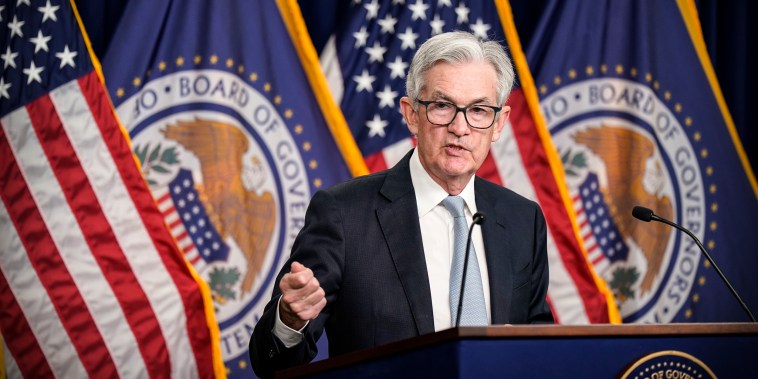Amid signs that price growth in the U.S. economy is rapidly cooling, the Federal Reserve announced Wednesday it was slowing the pace of its rate-hiking program designed to tackle inflation — but that more hikes were still on the table.
The Federal Open Market Committee said it was increasing its key federal funds rate by 0.5%, after announcing four-straight 0.75% hikes at its most recent meetings. In its Wednesday statement, the Fed said it continues to target an inflation rate of 2% over the long term and would continue to increase the federal funds rate to do so.
‘Inflation remains elevated, reflecting supply and demand imbalances related to the pandemic, higher food and energy prices, and broader price pressures,’ the committee said.
But bringing down inflation is likely to come at the cost of higher unemployment in the short term: The Fed said it now projects the 2023 unemployment rate to average 4.6%, equating to hundreds of thousands of more jobless workers compared with the current rate of 3.7%.
In response to a question from NBC News reporter Brian Cheung, Fed Chair Jerome Powell said that while there could be future potential ‘pain’ caused by higher unemployment, the difficulties Americans are currently experiencing with respect to inflation — and the risk that rapid price growth could continue — warrants keeping interest rates higher for longer.
‘I wish there was a painless way to restore price stability,’ Powell said. ‘There isn’t.’
The Labor Department on Tuesday reported that annual inflation clocked in at 7.1% in November — the lowest reading in more than a year. While it is still high compared to the 2% level at which the Federal Reserve typically seeks to hold down inflation, the most recent number signals that the galloping price growth earlier this year is fading.
The central bank has sought to increase the cost of borrowing and investing to pull back on price increases.
It appears to be working. In addition to the slower price growth, layoff announcements are mounting. To be clear, the Fed does not seek to create conditions that accelerate the need for job cuts. But the monetary tools it uses to keep inflation under control can, in some cases, lead to an economic slowdown that may force some businesses to reduce the size of their workforces.
Additional data this week from the New York Federal Reserve showed U.S. consumers now see inflation a year from now running at 5.2%, down by 0.7 percentage points from the previous month and the lowest year-ahead expectation since August 2021.
In fact, many investors are shifting their concerns from pervasive inflation to rapidly weakening growth, The Wall Street Journal reported Monday. Notably, demand for bonds has increased, reflecting growing interest in more stable returns that are often correlated with slower economic growth.
Out with inflation worries, in with recession fears
Key stock market gauges, meanwhile, continue to decline on concerns about flagging corporate earnings.
‘What we’ve seen over the past month is weakness in energy, weakness in the financial sector, weakness in the stock market and then [Treasury] rates going nowhere,’ said Michael Antonelli, the managing director at the financial services group Baird. ‘That’s a recipe for a market more worried about an economic slowdown than inflation. If it was still worried about inflation, then interest rates, energy and banks would all be higher. So all the telltale signs of inflation have all reversed.’
Even as signs point to softening price growth, the Fed must convince consumers and investors alike that it intends to stay the course on getting inflation under control, said Gregory Daco, the chief economist at EY-Parthenon, a unit of Ernst and Young LLP. That means it will continue to signal, for now, that it does not foresee any rate cuts in the near future.
‘The last thing the Fed wants to have is the tightening of financial conditions that are now priced in to get reversed,’ he said.
Still, analysts agree the Fed need not be as aggressive as it was forced to be for much of the year.
“Fed messaging is probably past peak hawkishness,” Bank of America economists said in a note Tuesday.
But it is increasingly likely that the Fed not only plans to halt rate hikes in the coming months; it also must begin planning for ways to reinvigorate a flagging economy.
In a note to clients Tuesday, James Knightley, the chief international economist at ING, said the “recessionary forces” coming to bear — like easing supply chain challenges, higher borrowing costs, slowing demand overseas and lower global energy prices — will mean the Fed could start cutting rates in the second half of 2023.
Mark Hamrick, a senior economic analyst at Bankrate, said in a note Tuesday that while a recession in 2023 is not a sure thing, there is now broad agreement that the risks of one remain and that the trade-off has already been made.
“To relieve individuals, households and businesses of historically high inflation, the Fed has been prepared to accept the risk of a recession if it achieves the mandate of stable prices,’ Hamrick said.
‘Choosing from the least of two evils,’ he added; ‘it isn’t dissimilar from when firefighters trade some damage from water for fire damage.”



























